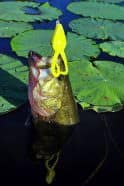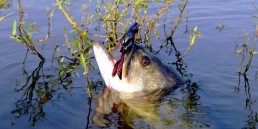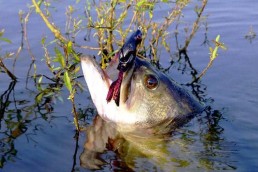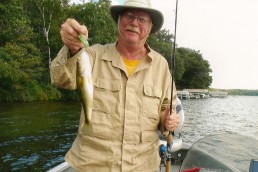Big Bass ‘Take the Fake’ Skimmed Over Thick Weeds
SHARE THIS POST
It’s not recommended for someone trying to “pound-up” for a weigh-in, but if it’s fun you’re after, hardly anything beats skittering lures over lily pads, milfoil and other thick grasses.
The most common lures for this method are made in the shape of frogs and rats, but I also use 6-inch Mann’s HardNose Worms Texas rigged without any weight.
You can fish these weedless baits over vegetation so thick that you wouldn’t think a fish could see or hear it. But big bass will break through this carpet of greenery and “take the fake,”—grass and all—in an explosive disturbance. The commotion is so sudden and violent it’s sometimes unnerving, but it makes me smile.

It’s not about the “fight,” because usually there isn’t one. When you set the hook, especially on a big fish, it’s already entwined in submerged vegetation. Even with heavy line and a hard pull, most of the better fish get off, and those you do manage to muscle in are garnished with such a thick blanket of salad that they can hardly wiggle.
The tricky part is setting the hook. Because the take is sudden, explosive and visible, the tendency is to set the hook too quickly, which most often pulls the bait right out the front of the fish’s mouth. To get a good, solid hook-set, it’s best to wait a second or two before yanking back on the rod. This gives the bass time to turn and head back down, so that when you do lay it to him the hooks are much more likely to find a hold.
It’s a catch-22 situation: If you try to set the hook when the bass first hits the bait and is near the surface, you’ll most often miss it. Or, if you wait until it heads down and turns, the bass will be tangled in the thick stuff the second you try to move him.
Are you enjoying this post?
You can be among the first to get the latest info on where to go, what to use and how to use it!
Sometimes you can force some of the smaller fish back to the surface and sort of skitter them back to the boat across the surface of the grass. Once in a while you’ll get lucky with a bigger bass that leaps as soon as it feels the hook. As long as you can keep him on or near the top, you’ve got a chance. Sometimes you can go in after them, mowing weeds with the trolling motor as you go. Most of the time, however, when they get tangled up, they get off.
I did lot of this type of fishing while guiding on Kentucky Lake. I’ve also fished frogs and rats and weightless worms on other impoundments, natural lakes, farm ponds, city lakes and watershed lakes. No matter the water, if it’s got a matted mantle of greenery, bass will be in it. The surface salad provides them with shade; the water is cooler, oxygenated and full of food.
Under these floating flora carpets is a jungle of stems, tunnels and lanes. Baitfish are drawn to it for the abundant hiding places, and bass are drawn to it because it contains many good ambush sites. Fish thrive in aquatic grasses, and I think some of them live there 24 hours a day because I’ve caught them at midnight, noon and in between. Fishing over the top of it requires a fairly stiff and long baitcasting outfit and line of at least 15-pound-test. Many anglers devoted to this specialized method prefer the stronger braided lines to muscle fish from the foliage. All you do is cast, hold the rod tip up to keep as much of the line off the surface as possible and reel back steadily. I’ve seen many fish these lures with pauses; I try that too occasionally, pausing at any small opening because it just seems logical. But most of my hits come on a slow, steady retrieve right over the thick stuff. My favorite way is to jiggle the rod tip during a slow retrieve, which makes the lure jiggle and swim like the real thing.
Judging by the way they go out of their way to burst through the floating foliage with a bulge and a spastic splash, this presentation pleasantly appeals to their predatory instincts—and my idea of maximum fun.
Ron Kruger has been communicating the outdoor experience for over four decades. He has worked as a full-time guide for trout on the North Fork, for crappies and bass on Kentucky Lake and for smallmouths on the Current River. He has served as editor of three outdoor magazines, and owns a patent on a fly/lure called the Desperate Diver.
MWO
SHARE THIS POST
Did you enjoy this post?
You can be among the first to get the latest info on where to go, what to use and how to use it!
Ron Kruger
Ron Kruger has been communicating the outdoor experience for more than four decades. He has worked as a full-time guide for trout on the North Fork, for crappies and bass on Kentucky Lake and for smallmouths on the Current River. He has served as editor of three outdoor magazines, and owns a patent on a fly/lure called the Desperate Diver.



